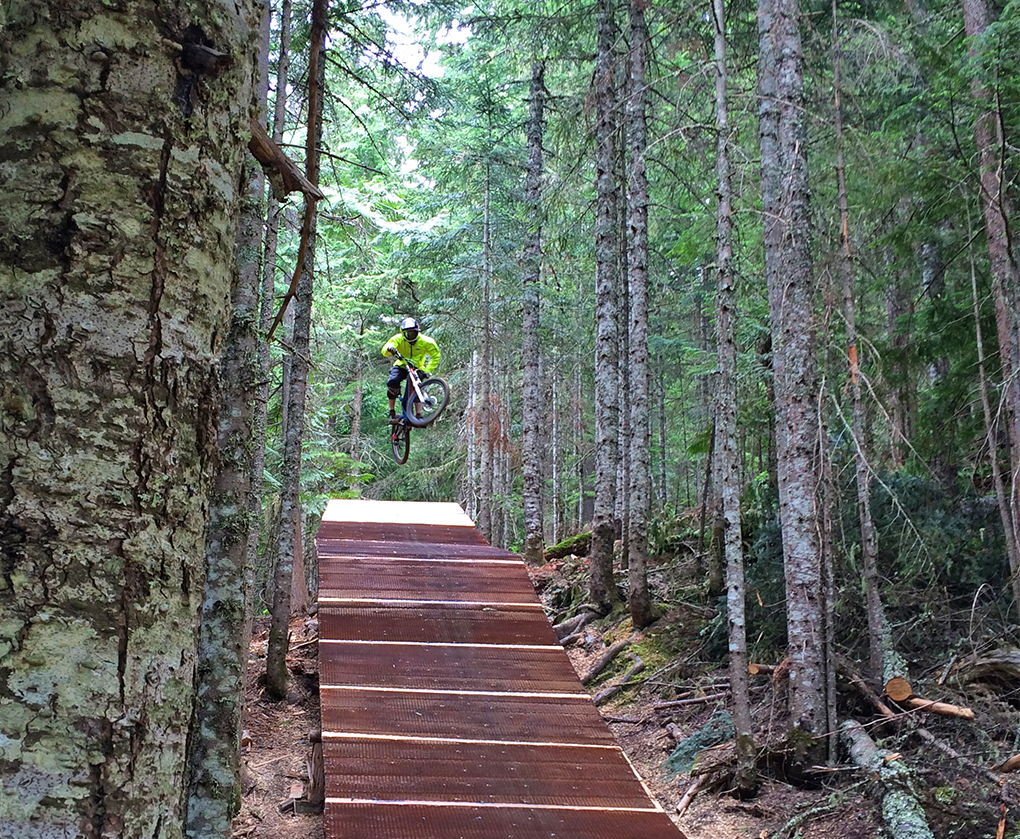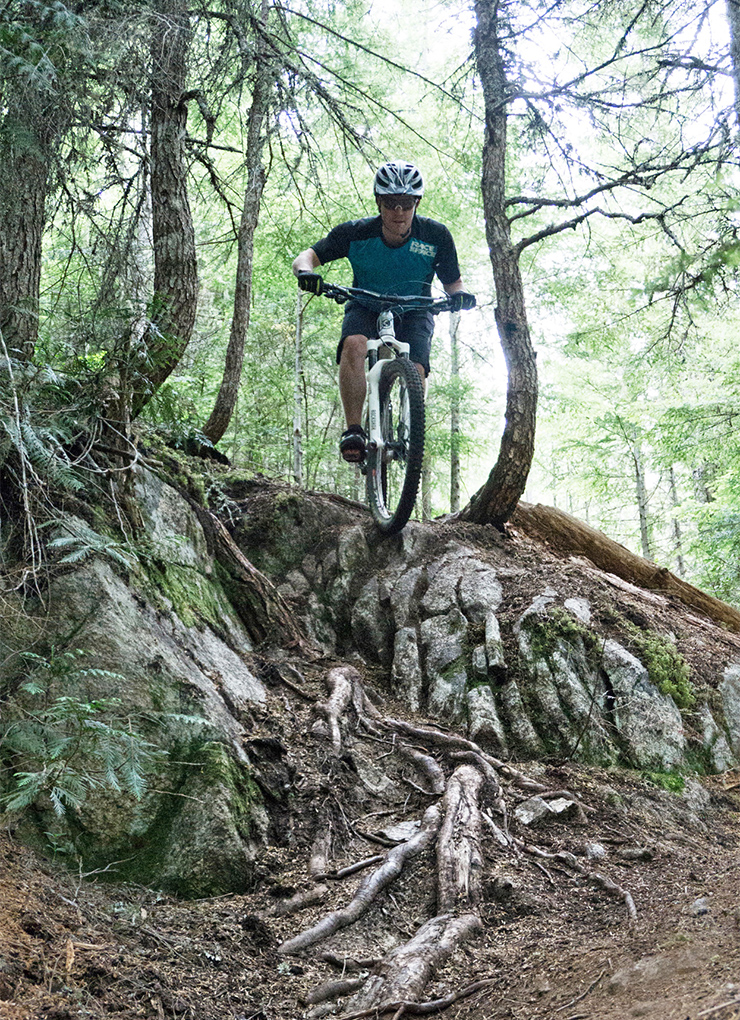Q: Do you think suspension travel should define intended use and bike character?
Noah: Not really. The intended use should define everything else about the bike, travel included. But, for better or worse, the travel / intended use categories have more or less settled out over the past 10 years, and I don’t think the current status of bike travel vs. intended use is all that out of whack.
That said, there are certainly plenty of bikes out there—shorter travel bikes in particular—that would benefit from some revised geometry. Some companies are on top of this, some not so much.

Marshal: No, not at all. Bike setup (bars, stem, seatpost, tires, brakes, suspension design and setup) have way more impact on how a bike rides than the wheel travel. With the prevalence of modern geometry, it is now, in my opinion, pretty irrelevant as well, as long as it is functional for the use. Most “important” geometry numbers are easily tuned with angle sets and eccentric shock bushings.
Tom: I think that it should play an important role, but perhaps not the headlining role it does now. It’d be great to see people obsess over it less—no one should discount a bike because it doesn’t have enough travel’.
More travel generally yields more margin for error on hard moves, saving your ass from time to time, so folks who want more travel for challenging riding aren’t making entirely unwarranted claims.

However, some of the most interesting bikes developed over the last decade are class-breaking: The Canfield Yelli Screamy, a slack 29er hardtail, the original Santa Cruz Blur 4x, short travel but slack, or the Kona Process bikes, focused more on geometry and less on travel.
Q: Is there another factor you think is more important? (I.e. instead of referring to bikes as belonging in the 5-6″ category, should we refer to them by something like the 66-65* head angle category?)
Noah: Not really. Travel is a convenient summary that, more often than not, gives at least a starting point to the discussion of what the bike will be good for. There’s any number of angles, lengths, and stats about a bike that can give me a decent clue as to where it’ll be most at home, but ultimately, there’s no single number on any bike that will tell the whole story, and if you need a quick figure to place the bike in the right ballpark, travel is as good an indicator as any.
Marshal: See above. The only numbers I pay attention to in any way are:
REACH – At 6’2’’, I want at least 460mm. At that length, I comfortably run a 60mm stem, and have no desire to resort to a longer than that. If the Reach bumps up to 470mm, I drop to a 50mm stem.
CHAINSTAY LENGTH – I prefer at least 17.3”, and look for 17.5”+. As a tall(ish) guy, I can leverage the rear and manual just fine for my tastes. I prefer the stability and traction with length, especially while climbing the prevalent loose gravel in Utah.
HEAD ANGLE – I only care that its in the right zone for the use. On a pedal bike, 67 to 69 is fine. For downhill bike terrain, I am in the 64 to 65 degree zone. It is easy to tune from there to speed up or slow down steering.
I am way more interested in the main pivot location relative to the chainring, and the stiffness of the headtube and bottom bracket junctures.

Tom: Head angle and chainstay length stand out to me as characteristics that determine the demeanor of a bike.
Short chainstays plus long travel is still a pretty nimble combination. Long chainstays, even on a hardtail, make for a planted and harder-to-maneuver bike (note that I’m 5’8” with short-ish legs and just can’t get my ass too far away from the middle of the bike to initiate turns or manuals, so unlike Marshal, shorter chainstays matter to me).
Second to chainstay length, but still important, is head angle. Steeper head angles improve slow-speed bike handling by increasing responsiveness, while slacker head angles make higher speeds comfortable by doing the opposite.
I’d take a slack, short travel bike over a long travel, steep bike any day if I wanted to go fast on descents.
Next Page: Final Thoughts

Suspension tuning and style wasn’t mentioned much. I’m not an expert tuner or anything, but even with flipping through dials and playing with air pressure, bikes, just like skis, do tend to have a certain personality of sorts. For example, lively, poppy and playful vs plush, stable and planted. For example, I found SB66s to feel more like the former (and skittish) and Nomads to feel more like the latter (and sluggish). Some of this could be geometry, but I think suspension characteristics are definitely playing a large role in the personality of the bike. I’m surprised this wasn’t mentioned by anyone. As an aside, I think shorter travel bikes are better suited towards the former, and longer travel bikes better suited towards the latter. I haven’t really looked at 275ers, mostly because they seem like a really poor allocation of my dollars with so many good 26ers going for dirt cheap (2 good bikes for the price of 1 mediocre, anyone?).
Really enjoyed this article. Great insights all around. I’m just going to need to convince the wife that I need a minimum of 3 mountain bikes. I’m sure it will go over great (haha). Lindahl, they actually have multiple articles on suspension including one that goes into a decent amount of depth on tuning your ride. Just go back to mountain biking 101 and you can find all the links there. Completely agree with your comment on the low prices of 26ers – unreal.
I’ve basically been in cryo-storage for the last decade as far as mountain bikes are concerned so this might be a question with an obvious answer but why aren’t there more long travel 29ers out there? I recently bought a Niner WFO and while I’m very happy with my purchase, there definitely isn’t the same level of selection in this category as there is in the LT 650b category. For instance, why doesn’t Santa Cruz make a 29er version of the Bronson? Is this a VHS / Beta question where one type of frame won the day “because”? Did these bikes initially come out and no one bought them? Are long travel 29ers the mono-skis of mountain biking? I’m obviously missing something. Interested in your thoughts. Thank you!
Andrew
When I first got onto a 29er this summer, my thought was that bigger wheels are to mountain biking what tip rocker is to skiing: they make the sport easier to do and therefore more accessible, more fun, etc. They’re not better than smaller wheels in every situation but in places where greasy roots and steep technical trails are common, I would imagine most riders would be happier on bigger wheels than smaller. So, when I started looking around for a new bike I was expecting to find lots of companies adopting them, across the spectrum of bike types, especially on enduro bikes. But what I found was that it’s mostly XC / trail bikes with less aggressive geometry and shorter travel (Santa Cruz Tallboy, Trek Remedy, Scott Spark, etc.) that have adopted 29″ wheels while the popular enduro (aggressive, long travel) bikes from Santa Cruz, Pivot, Devinci, Yeti, Norco, etc. are all 650b/27.5 – why is this? Maybe it’s because relatively short travel but aggressive 29ers like Evil’s The Following are facilitating the same kind of riding experience a LT 650b/27.5″ bike does (i.e. you don’t “need the extra travel because of the bigger wheels… but since when does that line of thinking apply to mountain bike manufacturers)?
Being short at 5’8″ and the lack of longer travel 29ers ruled wagon wheels out for me. I don’t buy the argument that the bigger wheel make up for 20mm of travel. Travel is travel. The real reason you don’t see long travel 29ers is that your already higher on them so longer travel would negativity impact the handling of the bike and create geometry issues. 140mm 27.5 hits the sweet spot for playful trail riding for me personally. I don’t care for flowy groomed trails so xc short travel bikes aren’t for me.
One more vote for the importance of the trails you ride:
Sure, langer travel bikeswap with slacker head angles climb very well these days.
So, out in the big mountains, you climb for 2 hours, then rip a sustained descent for 45 minutes, that’s a great set-up
On our Midwestern trails, much of the distance of a trail is spent on short rolling hills.
Having a bike that is lively pedaling out of the saddle on a short rise, having geometry that is nimble for the tight turns at slower speeds on the flats, and having firm suspension to pump every little feature, even on the uphills, makes that bike a lot more fun on these sort of trails.
So I’d argue there IS STILL a penalty for longer travel, slacker bikes.
Great article, give me more insights. Written well. We need more article like this in different subjects
Thanks
Beeson,
I am just under 6′-0″ and I feel that the 29ers with long travel are just way to Tall. I do not like to maneuver on stilts, and I would need a Medium with 29 and anything over 130 mm travel. also at some point the suspension will tweak, bind, or feel like it is hanging up as you are flicking around corners or clipping rocks.
I tend to use my dropper any time I see Technical or tight turns, and the high profile only helps for pedal strikes… not confidence in riding my outside lugs. We need a lower center of gravity without grinding down front cogs.
ah rereading ye ole comment speculation about a lack of LT 29rs… in 2024 is wild.